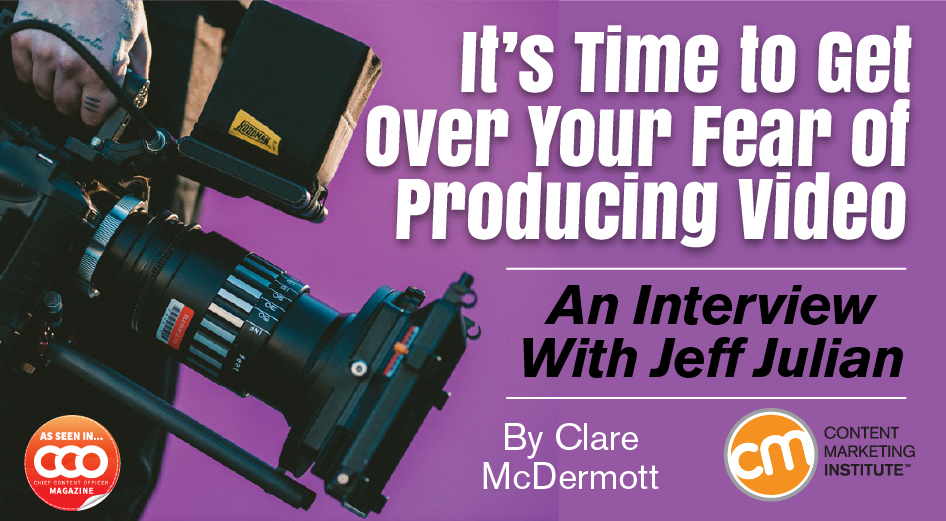Author: Clare McDermott / Source: Content Marketing Institute

Jeff Julian got his start in video at the ripe old age of 12. Video was a creative outlet for him during a challenging time … middle school.
“When I was in middle school, I went from an average size kid to a big kid,” Jeff explains. “I got picked on quite a bit. Playing with computers and electronics was a way for me to fit in and be creative. I began producing funny skits with my best friend. We impersonated ESPN, Saturday Night Live, and even Robin Leach from Lifestyles of the Rich and Famous. Our videos became popular at school. No one else was doing it so those videos came to define me when I was a kid.”
After college, Jeff became a full-time software developer, but in his spare time he was blogging and recording video about technology – even before “blog” was a common word. Ultimately, he built what became the biggest technology blog community at the time: Geeks With Blogs. (Robert Scoble was an early influencer of the blog.) “I wasn’t a marketer,” says Jeff. “I was a software developer who created this community – and I had to learn how to sell advertising to keep it going.” Over time, Jeff migrated to marketing, ultimately founding a marketing-focused video blog called Enterprise Marketer.

Jeff says marketers fear two primary aspects of video marketing. First, there’s tremendous anxiety about getting in front of the camera. He explains, “The fear of being judged scares people away from all video and audio media, even if they themselves aren’t the ones who will be in front of the camera.”
Also, Jeff says, marketers feel inadequate when it comes to transforming raw video assets into a final product. “I don’t think anyone’s afraid of things like cameras, lenses, tripods, or any technology on the recording end,” he says. “Their fear is about the production end of the process – the tools and expertise needed to make a complete project.”
Jeff shares his thoughts and tips on how to overcome that fear and learn to embrace video.
On why conquering fear matters more than ever
The way we consume content is moving more and more toward video, motion graphics, and audio. Of course, people have been saying this for years, but the growing sophistication of technologies like virtual reality, voice recognition (hello Alexa), and artificial intelligence means we will soon interact with screens very differently than we used to – and some screens will become obsolete. Add to that, younger generations are gravitating to video-based content in a way that will define how we publish in another decade. (Video-based recipes were uncommon even five years ago, but 30-second GIF recipes litter the web today.)
Content marketers need to look beyond the blog post, e-book, and print magazine; they have to adapt to the ways people prefer to consume content.
And I have not even mentioned live video or live streaming. Snapchat, Instagram, Facebook, and YouTube have all added live-streaming capabilities — and the format has taken off in popularity.
In short: Any brand that isn’t embracing video internally and growing its expertise is going to fall further and further behind.
On the virtues of starting small
To begin, think of the smallest audience you can impact with a short video. We’re talking the “babiest” of baby steps. For example, create a walk-through video of an internal tool you want your team to use. With such a small scope for your first video, the fear of rejection or being judged is low. Just make sure it’s valuable to that audience and lets you experiment with new tools and techniques in video production. It’s the video equivalent of writing a paragraph vs. a 10-page essay to get you comfortable with the process.
Another idea: Film a customer case study. You only need a single camera setup and an external microphone. Stand the camera left or right and ask customers to talk about themselves. (Just about everybody can talk about themselves and the projects they are a part of.) Cut up the clip, add motion graphics (you’ll find plenty of online tutorials), and show it to your sales reps. Ask them if it’s something they can use. If the answer is yes, you have another medium to jump on.
On when to consider a professional
It’s possible you’ll need a professional, but not in the way you might think.
It’s tough (read: impossible) to be in front of the camera and behind it at once. Depending on the quality and scope of your video project, you’ll need someone to assist you. That person, whether a professional or an assistant, should be trained to capture video and audio competently. (And more complex video projects may require even more people.)
If you want to get best bang for buck, consider hiring an independent videographer as your assistant. A freelance wedding videographer, for example, can help you through your beginner fears. Of course, you need…
Audience Team
The digital audience insights you need to build, manage and market to your digital audiences.

